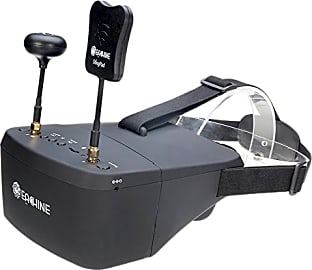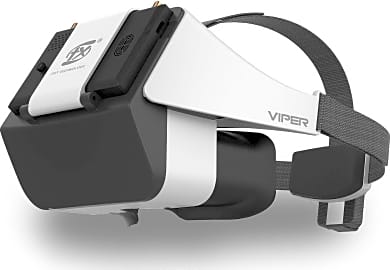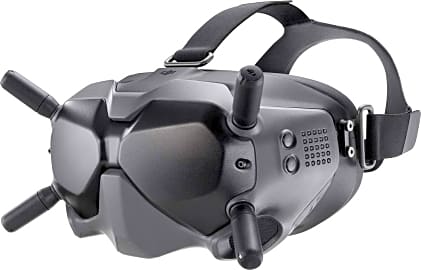The 7 Best FPV Goggles

This wiki has been updated 37 times since it was first published in June of 2016. Nothing beats the experience of piloting remote-controlled aircraft through high-speed maneuvers and attractive landscapes – except getting a first-person view of the action as you do so. These FPV goggles put you in the hot seat and let you enjoy all the excitement of racing a drone through the air or shooting stunning videos and stills, while keeping your feet firmly planted on the ground. When users buy our independently chosen editorial recommendations, we may earn commissions to help fund the Wiki.
Editor's Notes
March 17, 2021:
Most of our previous recommendations have gone out of production, and we're excited to say that there are a ton of great FPV headsets out there. If you really want something nice, it's tough to beat the Orqa FPV.One, although the Fat Shark Attitude V6 is right there with it. These, as well as the Skyzone SKY03O, are lightweight, low-profile, and advanced pieces of equipment that should satisfy the most demanding pilots.
If you wear glasses, the FXT Viper 2.0 are worth a look. The headset overall is awfully large, but it also performs admirably and with little latency. For those on the tightest budgets, the Arris VR-009 can work, but serious flyers will want to upgrade soon. One of the older models on our list, the Eachine EV800D, remains highly viable to this day, and it offers performance that's almost unrivaled in its price class.
We also really wanted to include some AR, or augmented reality options. Unfortunately, it looks like AR technology isn't quite there yet, as significant numbers of users report that even the most expensive AR glasses don't perform well enough, and aren't reliable enough, for consistent FPV usage.
January 02, 2020:
This category saw a fair amount of movement since we last visited it, with new models coming to market, old models being phased out or upgraded, and some holding their ground for having been built with an eye toward the future. The Epson Moverio BT-300 Smart Glasses is a forward-thinking pair that also got an upgrade. It's designed to offer a display against a clear background through which the user can see their surroundings. Unfortunately, they're among the most expensive options on the market, and they have a hard time dealing with ambient light.
Some important features include things like compatible input resolution, battery life, and field of view, and the DJI Digital HD Racing represent quite possibly the best balance of all these aspects. They're an upgrade to DJI's previous goggles on our list, and they offer some of the best range in the business, to boot. As a point of contrast, the Aomway Commander V1 was taken off the list for a combination of a narrow viewing angle and an input compatibility that stopped at 720p. With more drones running 1080p HD cameras as a minimum, even among budget options, the inability to accept those signals is near to a dealbreaker. The Flysight Falcon FG02 Wireless is an exception here, as it offers a slightly superior viewing angle and compatibility with twice the size of TF card, so you can record for longer without swapping it out.
Do You Need FPV Goggles?
Using goggles, you can close yourself off to what's happening on the ground and focus on your flight.
While you don’t necessarily need FPV goggles to fly your quadcopter or other drone, it can certainly enhance the experience and provide more flight accuracy than you would gain by simply watching your drone from the ground. FPV stands for “First Person View” and allows you to see exactly what your drone is seeing while in flight.
FPV goggles are intended for use with drones and other airborne remote-control devices. Most now come equipped with a built-in video camera and video transmitter, but some require that you attach your own independent device. The practice of FPV soared in popularity beginning in the late 2000s and continues to grow among drone enthusiasts.
With the right set of FPV goggles, you can fly your drone higher and farther than you could without. Some drones connect to your smartphone or tablet. However, this method does not provide the immersive experience provided by a high quality set of FPV goggles. Using goggles, you can close yourself off to what's happening on the ground and focus on your flight.
Quadcopters are capable of flying nearly anywhere and can take incredible aerial photographs. FPV goggles allow you to take full advantage of these features and avoid bumping into objects or obstacles that you might not see otherwise. FPV can help to prevent crashes or unnecessary damage to your drone by enhancing your view.
An Immersive Experience
The right set of FPV goggles can dramatically enhance your flight experience. As long as the goggles are compatible with your drone and its camera, your choice is based largely on environment and personal preference.
First, consider form factor. This simply means checking that the design is something that you are comfortable with and fits your purpose. There are two basic FPV goggle designs. The first is compact goggles. These are small and lightweight and tend to fit your head well. They are easily portable and won’t strain your head and neck. They are basic and use two small screens that fit over your eyes.
Some users opt to purchase an additional video receiver anyway because some built-in receivers don’t operate on a high enough frequency to suit their taste.
Box FPV goggles, on the other hand, use one large LCD screen for a better all-around view. They offer more features, including a camera on the goggles themselves so you can see in front or behind you without taking them off. These are preferred by a lot of drone pilots due to their versatility, but they can get a little heavy when worn for long periods.
Your drone camera has a specific aspect ratio of either 16:9 or 4:3. When purchasing your FPV goggles, you will have to ensure that the ratios on both camera and goggles match. Otherwise, it won’t matter how high-quality your goggles are, your picture will still be distorted.
The field of view refers to the degree that the edge of the screen is angled from your eyes while wearing the goggles. The higher the FOV number, the more immersive picture you will have. But like sitting too close to the screen at an IMAX theater, too wide a field can force your eyes to search in order to take in the whole image.
The video receiver frequency refers to the frequency that the FPV goggles use to communicate with the drone camera. Many goggles come readily equipped with a video receiver, but sometimes you have to purchase one separately. Some users opt to purchase an additional video receiver anyway because some built-in receivers don’t operate on a high enough frequency to suit their taste.
Head tracking is a pretty incredible feature found in some FPV goggles. It means that the camera on board the drone follows your head movements while wearing the goggles. It allows the camera's movements to correspond with your head movements, providing an even more immersive experience.
As with every product you intend to purchase, consider your budget. You don’t have to break the bank to buy a high quality set. In fact, you can go with some of the most basic, inexpensive sets and still have an incredible flying experience. However, the best, most advanced features tend to be available in only the more expensive sets.
A Brief History of FPV Goggles
First Person View technology has proven itself to be the most useful in the military. Drones have been utilized in some form since the 19th century beginning with hot air balloons in the American Civil War when they were rigged to drop explosives on enemy troops. The first genuine unmanned aerial vehicle was in 1916 when Archibald M. Low invented the “Aerial Target.”
Early FPV technology operated on low quality receivers and television screens, and there was a lot of work involved to set up these systems.
During World War II, Nazi Germany's UAV program saw the development and battlefield deployment of the V-1, which sparked the development of an American UAV program. As the advanced military drone technology eventually found its way into the hands of average citizens, it quickly became a tool for recreation.
The technology has advanced significantly through the years, and in the early twenty-first century, engineers and hobbyists began to build their own drones in their basements and garages. This hobby soared in popularity and prompted manufacturers to begin marketing drones for recreational use.
Early FPV technology operated on low quality receivers and television screens, and there was a lot of work involved to set up these systems. Thanks to military technology, drone enthusiasts, and entrepreneurs like Jordi Muñoz Bardales, FPV is now something that any drone hobbyist can enjoy at an affordable price.












